Abstract
Erosion damage is one of the main factors leading to failure of pipeline in oil field, especially for sudden contraction section under solid–liquid two-phase flow in hydraulic fracturing. In this article, a laboratory experiment was carried out to analyze the effects of pipe flow velocity, particle concentration and pipe inner diameter ratio on particle erosion of the reducing wall in high-viscosity liquid. The results show that the erosion rate and erosion distribution are different not only in radial direction but also in circumferential direction of the sample. The upper part of sample always has a minimum erosion rate and erosion area. Besides, the erosion rate of reducing wall is most affected by fluid flow velocity, and the erosion area is most sensitive to the change in the diameter ratio. Meanwhile, the erosion rate of reducing wall in cross-linked fracturing fluid is mainly determined by the fluid flowing state due to the high viscosity of the liquid. In general, the increase in flow velocity and diameter ratio not only causes the expansion of erosion-affected flow region in sudden contraction section, but also leads to more particles impact the wall.











Similar content being viewed by others
References
C. Rivard, D. Lavoie, R. Lefebvre et al., An overview of Canadian shale gas production and environmental concerns. Int. J. Coal Geol. 126, 64–76 (2013)
M. Parsi, K. Najmi, F. Najafifard et al., A comprehensive review of solid particle erosion modeling for oil and gas wells and pipelines applications. J. Nat. Gas Sci. Eng. 21, 850–873 (2014)
J.G.A. Bitter, Study of erosion phenomenon–1,2. Wear 5–21, 169–190 (1963)
I. Finnie, Erosion of surfaces by solid particles. Wear 3, 87–103 (1960)
G.L. Sheldon, A. Kanhere, Investigation of impingement erosion using single particles. Wear 21, 195–208 (1972)
I.M. Hutchings, R.E. Winter, Particle erosion of ductile metals: a mechanism of material removal. Wear 27, 121–128 (1974)
G.P. Tilly, Two stage mechanism of ductile erosion. Wear 23, 87–96 (1973)
A.V. Levy, Platelet mechanism of erosion of ductile metals. Wear 108, 1–21 (1986)
I.M. Hutchings, N.H. Macmillan, D.G. Rickerby, Further studies of the oblique impact of a hard sphere against a ductile solid. Int. J. Mech. Sci. 23, 639–646 (1981)
C. Huang, S. Chiovelli, P. Minev et al., A comprehensive phenomenological model for erosion of materials in jet flow. Powder Technol. 187, 237–279 (2008)
J.R. Cheng, N.S. Zhang, Z. Li et al., Erosion failure of horizontal pipe reducing wall in power-law fluid containing particles via CFD–DEM coupling method. J. Fail. Anal. Prev. 16, 1071–1081 (2017)
R. Malka, S. Nešić, D.A. Gulino, Erosion–corrosion and synergistic effects in disturbed liquid-particle flow. Wear 262(7–8), 791–799 (2007)
C.Y. Wong, C. Solnordal, A. Swallow et al., Experimental and computational modelling of solid particle erosion in a pipe annular cavity. Wear 303(1–2), 109–129 (2013)
Z. Lin, H. Xu, Y. Wang et al., Experimental study of particle erosion in a cavity with a height difference between its walls. Powder Technol. 286, 378–384 (2015)
W.S. Peng, X.W. Gao, Numerical prediction of erosion distributions and solid particle trajectories in elbows for gas–solid flow. J. Nat. Gas Sci. Eng. 30, 455–470 (2016)
X. Chen, B.S. McLaury, S.A. Shirazi, Application and experimental validation of a computational fluid dynamics (CFD)-based erosion prediction model in elbows and plugged tees. Comput. Fluids 33, 1251–1272 (2004)
Acknowledgments
This work was supported by the National Natural Science Foundation of China (Grant No. 51674199), and it was also performed by the Research Institute of Safety Evaluation and Control of Completion Test System.
Author information
Authors and Affiliations
Corresponding author
Rights and permissions
About this article
Cite this article
Cheng, J., Dou, Y., Zhang, J. et al. Experimental Study on Particle Erosion Failure of Abrupt Pipe Contraction in Hydraulic Fracturing. J Fail. Anal. and Preven. 18, 382–391 (2018). https://doi.org/10.1007/s11668-018-0409-5
Received:
Published:
Issue Date:
DOI: https://doi.org/10.1007/s11668-018-0409-5




